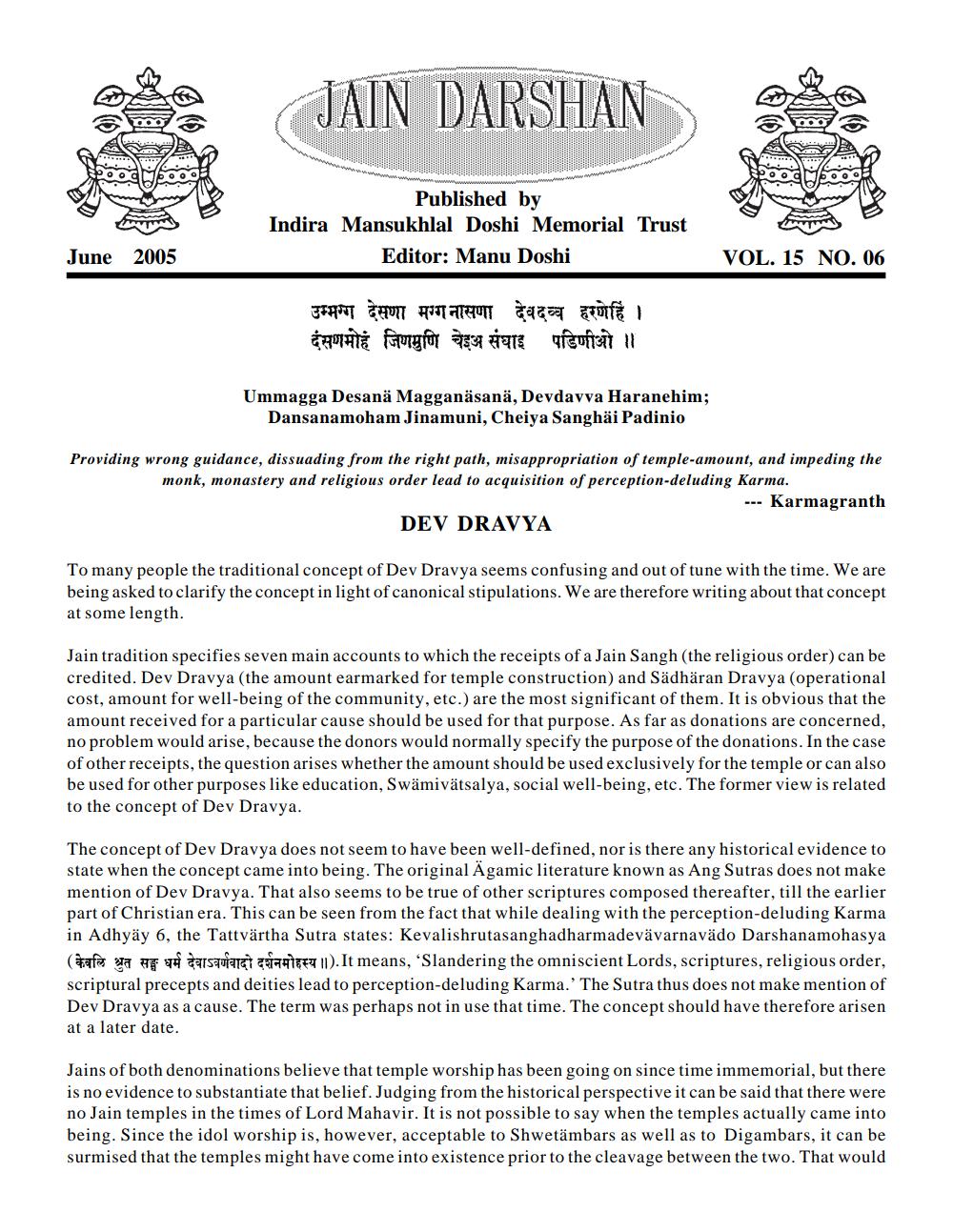Book Title: Dev Dravya Author(s): Manu Doshi Publisher: Manu Doshi View full book textPage 1
________________ Bo JAIN DARSHAN ny SC Published by Indira Mansukhlal Doshi Memorial Trust Editor: Manu Doshi June 2005 VOL. 15 NO. 06 उम्मग्ग देसणा मग्ग नासणा देवदव्व हरणेहिं । दसणमोहं जिणमुणि चेइअ संघाइ पडिणीओ ॥ Ummagga Desanä Magganäsanä, Devdavva Haranehim; Dansanamoham Jinamuni, Cheiya Sanghäi Padinio Providing wrong guidance, dissuading from the right path, misappropriation of temple-amount, and impeding the monk, monastery and religious order lead to acquisition of perception-deluding Karma. --- Karmagranth DEV DRAVYA To many people the traditional concept of Dev Dravya seems confusing and out of tune with the time. We are being asked to clarify the concept in light of canonical stipulations. We are therefore writing about that concept at some length. Jain tradition specifies seven main accounts to which the receipts of a Jain Sangh (the religious order) can be credited. Dev Dravya (the amount earmarked for temple construction) and Sädhäran Dravya (operational cost, amount for well-being of the community, etc.) are the most significant of them. It is obvious that the amount received for a particular cause should be used for that purpose. As far as donations are concerned, no problem would arise, because the donors would normally specify the purpose of the donations. In the case of other receipts, the question arises whether the amount should be used exclusively for the temple or can also be used for other purposes like education, Swämivätsalya, social well-being, etc. The former view is related to the concept of Dev Dravya. The concept of Dev Dravya does not seem to have been well-defined, nor is there any historical evidence to state when the concept came into being. The original Agamic literature known as Ang Sutras does not make mention of Dev Dravya. That also seems to be true of other scriptures composed thereafter, till the earlier part of Christian era. This can be seen from the fact that while dealing with the perception-deluding Karma in Adhyay 6, the Tattvärtha Sutra states: Kevalishrutasanghadharmadevävarnavädo Darshanamohasya (aft a TF Te darstufat AEETII). It means, 'Slandering the omniscient Lords, scriptures, religious order, scriptural precepts and deities lead to perception-deluding Karma.' The Sutra thus does not make mention of Dev Dravya as a cause. The term was perhaps not in use that time. The concept should have therefore arisen at a later date. Jains of both denominations believe that temple worship has been going on since time immemorial, but there is no evidence to substantiate that belief. Judging from the historical perspective it can be said that there were no Jain temples in the times of Lord Mahavir. It is not possible to say when the temples actually came into being. Since the idol worship is, however, acceptable to Shwetämbars as well as to Digambars, it can be surmised that the temples might have come into existence prior to the cleavage between the two. That wouldPage Navigation
1 2 3 4 5 6 7 8
